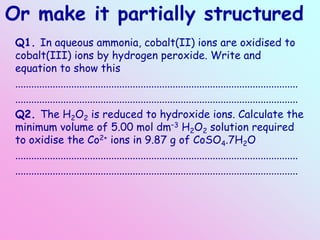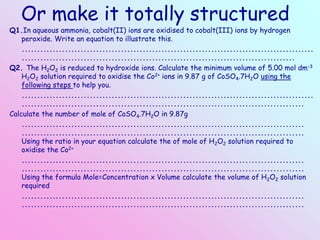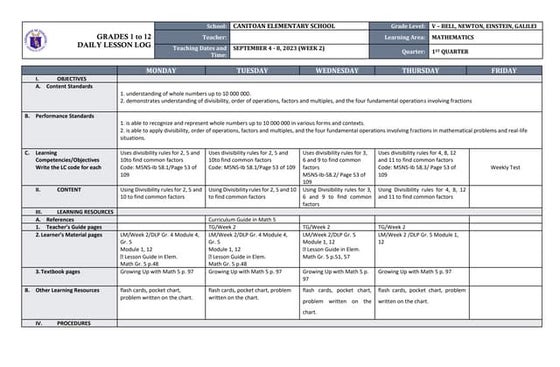Vasy & Helen
- 1. 1. Philip Banseylla 2. Jimmy Campbell 3. Ruth Cooper 4. Steve Dobson 5. Anna Finn 6. Margery Gretton 7. Claire Hills 8. Hannah Johnston 9. Danny Kuperberg 10.Maeveen Maenpaa 11.Nigel Martin 12.Wendy Oswin 13.Jal Patel 14.Christine Phillips 15.Lucy Ridgway 16.Niki Savva 17.Mary Sell 18.Cressida Tweed 19.Pete Weitz 20.Chris Wickham
- 3. Differentiation Today we will think about differentiation.. 9.00 â 9.20: Some examples of differentiation activities shared by the ASTâs 9.20 â 11.20: Time in departments 11.20 â 12.00: Feedback in this room âĒ We will ask you in departments to come up with : (1) an example of how you could use one of the ideas (2) more differentiation ideas of your own to share 03/06/2013Helen
- 4. What is Differentiation? âĒ Simply stated, differentiation is modified instruction âĒ that helps students with diverse academic needs âĒ and learning styles master the same challenging academic content. 03/06/2013Helen What is Differentiation?
- 5. How Can We Differentiate? 03/06/2013Helen Vary Materials Vary Process Vary Assessment
- 6. Vary Materials âĒ Changing the materials used in the classroom can be an effective way to differentiate âĒ For example......... âĒ Snowball activity âĒ Change the materials each student is given 03/06/2013Vasy
- 7. Snowball Activity PLANNING THE ACTIVITY âĒ Create 3 differentiated âsourcesâ of information âĒ Eg: with diagrams, simple text, complex text âĒ Each source has different information (so they must work as a group to get an overview of the topic) âĒ Using different levels of thinking...
- 8. Snowball Activity STUDENT ACTIVITY âĒ Working in groups of 3 âĒ As Individuals: Students read their source material and highlight relevant points âĒ As a Group: They feedback information to each other to create an overview âĒ Group constructs a concept map âĒ As a class: compare and feedback on each others concept maps
- 10. Concept MapsâĶ How do I?
- 11. Secondary School Students Exams Homework Teachers Staff Room Cool A Concept Map about Secondary School Arrange the keywords
- 12. Secondary School Students Exams Homework Teachers Staff Room Cool A Concept Map about Secondary School Join up with arrows
- 13. Secondary School Students Exams Homework Teachers Staff Room has angelic always do their love has fantabulous plot secretly in has a Cool are A Concept Map about Secondary School Add 1 or 2 words You can pick your own keywords & Use FLOW DIAGRAMS ETC BE Imaginative... Colourful.... Representative... .....unique
- 14. QUESTIONS YOU ALL MUST ANSWER: 1. List the 3 components of a nucleotide 2. Describe how these 3 components of a nucleotide are added together (ie what type of reaction is used) 3. Draw the structre of a nucleotide 4. Write out the name for all 4 DNA bases (ie not just the 4 letters!) 5. Explain which of the 4 DNA bases pair together Extension knowledge: 1. Explain how each of these DNA base pairs are held together in a DNA molecule Instructions:
- 15. Vary Process âĒ Changing the instructions of activities will allow all students to learn the same concepts and skills âĒ But with varied levels of âsupport, challenge, or complexityâ âĒ For example......... 03/06/2013Helen
- 16. In Chemistry âĒ We can set a problem: âĒ In aqueous ammonia, cobalt(II) ions are oxidised to cobalt(III) ions by hydrogen peroxide. The H2O2 is reduced to hydroxide ions. Calculate the minimum volume of 5.00 mol dmâ3 H2O2 solution required to oxidise the Co2+ ions in 9.87 g of CoSO4.7H2O âĒ And leave it totally unstructured
- 17. Or make it partially structured Q1. In aqueous ammonia, cobalt(II) ions are oxidised to cobalt(III) ions by hydrogen peroxide. Write and equation to show this .......................................................................................................... .......................................................................................................... Q2. The H2O2 is reduced to hydroxide ions. Calculate the minimum volume of 5.00 mol dmâ3 H2O2 solution required to oxidise the Co2+ ions in 9.87 g of CoSO4.7H2O .......................................................................................................... ..........................................................................................................
- 18. Or make it totally structured Q1.In aqueous ammonia, cobalt(II) ions are oxidised to cobalt(III) ions by hydrogen peroxide. Write an equation to illustrate this. .............................................................................................. ........................................................................................ Q2. The H2O2 is reduced to hydroxide ions. Calculate the minimum volume of 5.00 mol dmâ3 H2O2 solution required to oxidise the Co2+ ions in 9.87 g of CoSO4.7H2O using the following steps to help you. .............................................................................................. ........................................................................................... Calculate the number of mole of CoSO4.7H2O in 9.87g ........................................................................................... ........................................................................................... Using the ratio in your equation calculate the of mole of H2O2 solution required to oxidise the Co2+ ........................................................................................... ........................................................................................... Using the formula Mole=Concentration x Volume calculate the volume of H2O2 solution required ........................................................................................... ...........................................................................................
- 19. Extension âĒ When students have finished they have the option of changing the level of structure in the question they attempt âĒ By either: (1) attempting a similar level of question (2) attempting a more difficult question
- 20. Vary Assessment âĒ Vary methods of assessment, giving students options when it comes to demonstrating their understanding of the topic âĒ This allows for another form of differentiation for example...............
- 21. Vary Assessment âĒ Display Blooms Taxonomy on IWB âĒ Challenge students to identify the different ways of constructing questions, to reflect the different levels of thinking âĒ Ask them to write an exam question that covers each of the levels of thinking & markscheme âĒ Asking the class to try these questions & feeding back
- 22. Different Order Questions Knowledge List, define, tell, recall, identify, label, collect, tabulate, quote, name, who, when, where Comprehension Summarize, describe, interpret, contrast, associate, distinguish, estimate, differentiate, discuss, extend Application Apply, demonstrate, calculate, complete, illustrate, predict, show, solve, examine, modify, relate, change, classify, experiment, discover, use Analysis Analyze, separate, order, explain, connect, classify, arrange, divide, compare, select, explain, infer, break down, differentiate Synthesis Combine, integrate, modify, rearrange, substitute, plan, create, design, invent, what if?, compose, formulate, prepare, generalize, rewrite Evaluation Assess, evaluate, appraise, justify, defend, decide, rank, grade, test, measure, recommend, convince, select, judge, discriminate, support, conclude, compare, summarize
- 23. The Stuck Menu Students choose 3 strategies from âThe Stuck Menuâ before putting up their hand to ask for help... 1. Leave a question that you find difficult until later, try an easier question first 2. Look back through your notes and previous examples 3. Use a text book/smart-phone 4. Ask someone else in your group 5. Use a dictionary to look up a word Helen
- 24. The Lazy Teacherâs Handbook Unlocking potential with language (Jim Smithâs The Lazy Teacherâs Handbook: developing an independent learning structure) âWhat have you forgotten to do?â âIf you were not stuck, what would you do?â âTry something different...â âIf I gave you a million pounds to be unstuck, what would you do?â âWhat could you do to help yourself?â Helen
- 25. Focus 9.20 â 11.20: Time in departments 1. Think of a way in which your department could use at least one of the techniques we have just shown you 2. Also discuss other differentiation activities so that you have a new idea to feed back to use at 11.20 3. Share your new questioning idea on the blog 11.20 â 12.00: Feedback in this room Vasy
- 26. Time to feedback
- 27. Where can I get the information from today? âĒ Shared area â Folder called âASTâ. âĒ This folder has all the slides used for today, including the other groups slides.
- 28. Helen
- 29. Differentiation âĒ Show students blooms question âĒ Construct a past paper question âĒ Using different levels of thinking âĒ Write a markscheme âĒ Swap and try each others questions âĒ Swap and mark âĒ Feedback to class, show example questions and answers































































